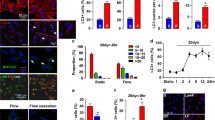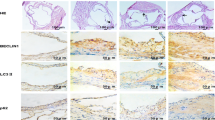Abstract
Phenotypic modulation of vascular smooth muscle cells (VSMCs) is involved in the pathophysiological processes of the intracranial aneurysms (IAs). Although shear stress has been implicated in the proliferation, migration, and phenotypic conversion of VSMCs, the molecular mechanisms underlying these events are currently unknown. In this study, we investigated whether shear stress(SS)-induced VSMC phenotypic modulation was mediated by autophagy involved in adenosine monophosphate-activated protein kinase (AMPK)/mammalian target of rapamycin (mTOR)/Unc-51-like kinase 1 (ULK1) pathway. The results show that shear stress could inhibit the expression of key VSMC contractile genes and induce pro-inflammatory/matrix-remodeling genes levels, contributing to VSMCs phenotypic switching from a contractile to a synthetic phenotype. More importantly, Shear stress also markedly increased the levels of the autophagy marker microtubule-associated protein light chain 3-II (LC3II), Beclin-1, and p62 degradation. The autophagy inhibitor 3-methyladenine (3-MA) significantly blocked shear-induced phenotypic modulation of VSMCs. To further explore the molecular mechanism involved in shear-induced autophagy, we found that shear stress could activate AMPK/mTOR/ULK1 signaling pathway in VSMCs. Compound C, a pharmacological inhibitor of AMPK, significantly reduced the levels of p-AMPK and p-ULK, enhanced p-mTOR level, and finally decreased LC3II and Beclin-1 level, which suggested that activated AMPK/mTOR/ULK1 signaling was related to shear-mediated autophagy. These results indicate that shear stress promotes VSMC phenotypic modulation through the induction of autophagy involved in activating the AMPK/mTOR/ULK1 pathway.





Similar content being viewed by others
References
Ali MS, Starke RM, Jabbour PM, Tjoumakaris SI, Gonzalez LF, Rosenwasser RH, Owens GK, Koch WJ, Greig NH, Dumont AS (2013) TNF-α induces phenotypic modulation in cerebral vascular smooth muscle cells: implications for cerebral aneurysm pathology. J Cereb Blood Flow Metab 33(10):1564–1573
Brisman JL, Song JK, Newell DW (2006) Cerebral aneurysms. N Engl J Med 355(9):928–939
Can A, Du R (2016) Association of hemodynamic factors with intracranial aneurysm formation and rupture: systematic review and meta-analysis. Neurosurgery 78(4):510–520
Chalouhi N, Ali MS, Jabbour PM, Tjoumakaris SI, Gonzalez LF, Rosenwasser RH, Koch WJ, Dumont AS (2012) Biology of intracranial aneurysms: role of inflammation. J Cereb Blood Flow Metab 32(9):1659–1676
Chalouhi N, Hoh BL, Hasan D (2013) Review of cerebral aneurysm formation, growth, and rupture. Stroke 44(12):3613–3622
Chen S, Liu B, Kong D, Li S, Li C, Wang H, Sun Y (2015) Atorvastatin calcium inhibits phenotypic modulation of PDGF-BB-induced VSMCs via down-regulation the Akt signaling pathway. PLoS ONE 10(4):e0122577
Cheng Y, Wang B, Zhou H, Dang S, Jin M, Shi Y, Hao L, Yang Z, Zhang Y (2015) Autophagy is required for the maintenance of liver progenitor cell functionality. Cell Physiol Biochem 36(3):1163–1174
De Meyer GR, Grootaert MO, Michiels CF, Kurdi A, Schrijvers DM, Martinet W (2015) Autophagy in vascular disease. Circ Res 116(3):468–479
Kataoka H (2015) Molecular mechanisms of the formation and progression of intracranial aneurysms. Neurol Med Chir 55(3):214–229
Kim J, Kundu M, Viollet B, Guan KL (2011) AMPK and mTOR regulate autophagy through direct phosphorylation of Ulk1. Nat Cell Biol 13(2):132–141
Kono K, Fujimoto T, Terada T (2014) Proximal stenosis may induce initiation of cerebral aneurysms by increasing wall shear stress and wall shear stress gradient. Int J Numer Methods Biomed Eng 30(10):942–950
Li J, Zhao L, Yang T, Zeng YJ, Yang K (2014) c-Ski inhibits autophagy of vascular smooth muscle cells induced by oxLDL and PDGF. PLoS ONE 9(6):e98902
Li R, Zhou P, Guo Y, Lee J-S, Zhou B (2017) Tris(1,3-dichloro-2-propyl) phosphate induces apoptosis and autophagy in SH-SY5Y cells: involvement of ROS-mediated AMPK/mTOR/ULK1 pathways. Food Chem Toxicol 100:183–196
Nakajima N, Nagahiro S, Sano T, Satomi J, Satoh K (2000) Phenotypic modulation of smooth muscle cells in human cerebral aneurysmal walls. Acta Neuropathol 100(5):475–480
Opitz F, Schenke-Layland K, Cohnert TU, Stock UA (2007) Phenotypical plasticity of vascular smooth muscle cells-effect of in vitro and in vivo shear stress for tissue engineering of blood vessels. Tissue Eng 13(10):2505–2514
Ruzevick J, Jackson C, Pradilla G, Garzon-Muvdi T, Tamargo RJ (2013) Aneurysm formation in proinflammatory, transgenic haptoglobin 2-2 mice. Neurosurgery 72(1):70–76
Salabei JK, Hill BG (2013) Implications of autophagy for vascular smooth muscle cell function and plasticity. Free Radic Biol Med 65(6):693–703
Salabei JK, Hill BG (2015) Autophagic regulation of smooth muscle cell biology. Redox Biol 27:97–103
Sawyer DM, Pace LA, Pascale CL (2016) Lymphocytes influence intracranial aneurysm formation and rupture: role of extracellular matrix remodeling and phenotypic modulation of vascular smooth muscle cells. J Neuroinflamm 13(1):185
Starke RM, Chalouhi N, Ding D (2014) Vascular smooth muscle cells in cerebral aneurysm pathogenesis. Transl Stroke Res 5(3):338–346
Wang L, Andersson M, Karlsson L, Watson MA, Cousens DJ, Jern S, Erlinge D (2003) Increased mitogenic and decreased contractile P2 receptors in smooth muscle cells by shear stress in human vessels with intact endothelium. Arterioscler Thromb Vasc Biol 23(8):1370–1376
Wang J, Yan CH, Li Y, Xu K, Tian XX, Peng CF, Tao J, Sun MY, Han YL (2013) MicroRNA-31 controls phenotypic modulation of human vascular smooth muscle cells by regulating its target gene cellular repressor of E1A-stimulated genes. Exp Cell Res 319(8):1165–1175
Wang J, Qi Q, Feng Z, Zhang X, Huang B, Chen A, Prestegarden L, Li X (2014) Berberine induces autophagy in glioblastoma by targeting the AMPK/mTOR/ULK1-pathway. Oncotarget 7(41):66944–66958
Xiao Q, Chen Q, Feng Y (2015) miRNA-34a reduces neointima formation through inhibiting smooth muscle cell proliferation and migration. J Mol Cell Cardiol 89(Pt A):75–86
Zhang Y, Takao H, Murayama Y, Qian Y (2013) Propose a wall shear stress divergence to estimate the risks of intracranial aneurysm rupture. Sci World J 9:160–169
Zhang Y, Jing L, Ying Z, Jian L, Yang X (2016) Low wall shear stress is associated with the rupture of intracranial aneurysm with known rupture point: case report and literature review. BMC Neurol 16(1):231
Acknowledgements
The authors would like to thank Li Yan and Ying-Ji Li for experimental assistance. This work was supported by the China Postdoctoral Science Foundation (2015M580117), and the Project was supported by Beijing Postdoctoral Research Foundation (2015ZZ-49 and 2016ZZ-38).
Author information
Authors and Affiliations
Contributions
LS and ML were responsible for experimental design and they revised the paper. MZ wrote the manuscript. AL carried out the experiments and analyzed the data. JZ prepared the figures and tables. YL, XY, and ZW contributed some reagents and provided technical support.
Corresponding authors
Ethics declarations
Conflict of interest
The authors declare no conflict of interest.
Rights and permissions
About this article
Cite this article
Sun, L., Zhao, M., Liu, A. et al. Shear Stress Induces Phenotypic Modulation of Vascular Smooth Muscle Cells via AMPK/mTOR/ULK1-Mediated Autophagy. Cell Mol Neurobiol 38, 541–548 (2018). https://doi.org/10.1007/s10571-017-0505-1
Received:
Accepted:
Published:
Issue Date:
DOI: https://doi.org/10.1007/s10571-017-0505-1




